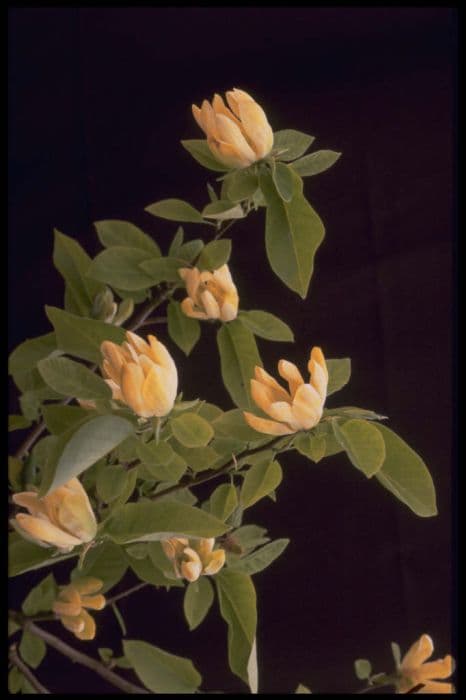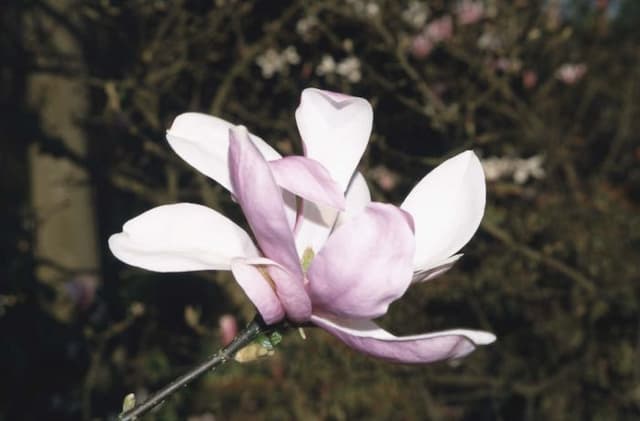Daphne Magnolia Magnolia 'Daphne'

ABOUT
Magnolia 'Daphne' is a striking ornamental plant known for its vibrant, large flowers. These blooms are generally tulip-shaped and boast a rich, yellow color, often with a slight flush at the base, providing a mesmerizing contrast against the green foliage. The flowers of 'Daphne' emit a delightful fragrance that is sweet and refreshing. This magnolia presents with glossy, dark green leaves that provide a lush backdrop to the bright blossoms. The plant maintains an elegant, broad form and can be a magnificent focal point in any garden landscape where it exudes a sense of grace and beauty.
About this plant
 Names
NamesFamily
Magnoliaceae
Synonyms
Yellow Bird Magnolia, Daphne Magnolia
Common names
Magnolia 'Daphne'
 Toxicity
ToxicityTo humans
The Magnolia 'Daphne' is not commonly listed as a toxic plant to humans. However, eating parts of magnolias in general is not advisable. While specific toxicity information about Magnolia 'Daphne' is limited, magnolias are typically not considered poisonous to humans. In general, if a person were to ingest parts of a magnolia plant, such as leaves or flowers, it is unlikely to cause serious harm. That said, it is possible for individuals to experience mild stomach upset or an allergic reaction. If any part of the plant has been ingested and there is a concern, it is best to contact a medical professional.
To pets
The Magnolia 'Daphne', like most magnolia varieties, is not listed as a toxic plant to pets by major animal care organizations. Most parts of magnolia trees, including the leaves and flowers, are generally considered non-toxic to pets such as dogs and cats. However, ingestion of plant material can sometimes lead to gastrointestinal upset in pets, such as vomiting or diarrhea, due to the physical irritation or natural compounds in the plants, not necessarily because of toxicity. If you suspect your pet has ingested a large amount of magnolia plant material and is showing signs of distress, it's recommended to consult a veterinarian.
 Characteristics
CharacteristicsLife cycle
Perennials
Foliage type
Evergreen
Color of leaves
Green
Flower color
Yellow
Height
4-5ft [1.2-1.5m]
Spread
4-5ft [1.2-1.5m]
Plant type
Shrub
Hardiness zones
7-9
Native area
Hybrid
Benefits
 General Benefits
General Benefits- Aesthetic Appeal: Magnolia Daphne is known for its beautiful, tulip-shaped yellow flowers that can add striking visual interest to any landscape.
- Fragrance: It emits a delightful fragrance, which can enhance the sensory experience of a garden or yard.
- Attracts Pollinators: The flowers attract bees and other pollinators, which are essential for the health of many ecosystems and the production of fruits and seeds.
- Shade Provider: As a tree, it can offer a significant amount of shade, creating cooler areas in gardens and reducing the need for air conditioning in nearby buildings.
- Longevity: Magnolias are known for their long life span, making them a lasting addition to a landscape.
- Seasonal Interest: It provides year-round interest with its evergreen leaves, spring and summer flowers, and sometimes interesting seed pods in the fall.
- Low Maintenance: Once established, Magnolia Daphne is relatively low maintenance, requiring minimal care.
- Drought Resistance: Mature trees have some level of drought tolerance, making them suitable for various climates.
- Privacy Screen: Can be used as a natural privacy screen or windbreak when planted in rows or clusters.
- Property Value: Attractive trees like the Magnolia Daphne can increase property value by enhancing the landscape’s visual appeal.
 Medical Properties
Medical PropertiesThis plant is not used for medical purposes.
 Air-purifying Qualities
Air-purifying QualitiesThis plant is not specifically known for air purifying qualities.
 Other Uses
Other Uses- Floral arrangements: Magnolia flowers can be used in fresh floral arrangements to add a touch of elegance and a sweet fragrance to any room.
- Photography prop: The large, attractive blooms of Magnolias make them a favorite among photographers for nature photography or as a backdrop for portraits.
- Craft materials: Dried magnolia leaves can be used in crafting, such as making wreaths, garlands, or other decorative items for the home.
- Culinary garnish: The flowers can be used as a beautiful, albeit non-traditional, garnish for special gourmet dishes.
- Natural dye: The bark and flowers of Magnolia can be boiled to make natural dyes for coloring fabrics or paper.
- Perfumery: The scent of Magnolia flowers can be used in the production of perfumes and scented oils, offering a sweet and captivating aroma.
- Furniture ornamentation: Magnolia wood, due to its hardness and aesthetics, can be used for carving decorative elements in fine furniture manufacturing.
- Plant grafting: Magnolia trees can be used as rootstocks for grafting other magnolia species or varieties to propagate new plants.
- Festival decor: Magnolia can be incorporated into decor for festivals or celebrations, especially in the Southern United States, where it's often associated with traditional events.
- Book pressing: The Magnolia's large leaves and flowers can be used in the old hobby of flower pressing for preserving in books or making botanical displays.
Interesting Facts
 Feng Shui
Feng ShuiThe Magnolia is often associated with purity and nobility in Feng Shui. To use it, place the Magnolia in areas that require an uplifting energy or where a sense of peace and tranquility is desired, such as a living room or garden. The white blossoms are particularly good for representing metal elements and enhancing clarity and focus.
 Zodiac Sign Compitability
Zodiac Sign CompitabilityThe Magnolia is not used in astrology practice.
 Plant Symbolism
Plant Symbolism- Nobility: The magnolia, with its large, impressive blossoms, is often associated with nobility and dignity, reflecting a person's dignified presence or character.
- Persistence: Magnolias have the ability to withstand harsh conditions, symbolizing persistence and endurance through life's challenges.
- Femininity and Beauty: With its delicate petals and graceful appearance, the magnolia symbolizes femininity and beauty, often used to convey the inner and outer beauty of an individual.
- Purity: The pure white color of many magnolia flowers is a symbol of purity and cleanliness, signaling innocence or a fresh start.
 Water
WaterThe Yellow Tulip Magnolia, commonly known as Magnolia 'Daphne', prefers consistently moist soil but it is vital to avoid overwatering. It should be watered deeply to ensure the water reaches the root zone, using approximately 3 gallons of water every week during the growing season. In hot or very dry conditions, the frequency should be increased to twice a week. During the dormant winter period, reduce watering to every two weeks, providing the same amount of 3 gallons unless rainfall sufficiently maintains soil moisture.
 Light
LightMagnolia 'Daphne', also known as the Yellow Tulip Magnolia, thrives in full sun to partial shade. The ideal spot would be one where the plant receives at least 4 hours of direct sunlight each day. However, in hotter climates, some afternoon shade is beneficial to protect the blooms from excessive heat.
 Temperature
TemperatureThe Yellow Tulip Magnolia does well in a wide range of temperatures but prefers a range between 60 to 70 degrees Fahrenheit. It can survive minimum temperatures down to around 0 degrees Fahrenheit but ideally should not be exposed to prolonged periods of severe cold. Maximum temperatures should not exceed 90 degrees Fahrenheit to prevent stress on the plant.
 Pruning
PruningThe Yellow Tulip Magnolia benefits from pruning to maintain shape and remove any dead or damaged branches. Pruning should be carried out in late winter or early spring before new growth starts. Typically, an annual pruning is enough for healthy maintenance, focusing on cutting just above the bud nodes to encourage new growth.
 Cleaning
CleaningAs needed
 Soil
SoilThe ideal soil mix for Magnolia 'Daphne', commonly known as Daphne Magnolia, should be rich, well-drained, and slightly acidic to neutral with a pH between 5.5 and 7.0. A mixture composed of equal parts loamy soil, peat moss, and perlite or sand would provide the right structure and nutrients for optimal growth.
 Repotting
RepottingDaphne Magnolia does not need to be repotted frequently. It is generally recommended to repot every 2 to 3 years, or when the plant has outgrown its current container. Spring is the best time to repot this plant to minimize stress and promote healthy growth during the growing season.
 Humidity & Misting
Humidity & MistingDaphne Magnolia thrives in moderate humidity levels. Aim for humidity around 50% for optimal growth. While this plant is somewhat adaptable, maintaining consistent humidity will contribute to its overall health and flowering success.
 Suitable locations
Suitable locationsIndoor
Provide bright indirect light and consistent moisture.
Outdoor
Plant in partial shade with well-draining soil.
Hardiness zone
7-9 USDA
 Life cycle
Life cycleThe life of Magnolia 'Daphne', commonly known as Daphne Magnolia, begins with seed germination, where the seeds require a period of warm stratification followed by cold stratification to break dormancy. Once germinated, the seedling stage involves the growth of basic root systems and foliage until it becomes a young plant. As it reaches the juvenile phase, the plant focuses on rapid vegetative growth to establish a sturdy root system and branching structure. Transitioning to the mature phase, the Daphne Magnolia starts to flower, typically in early spring, featuring vibrant yellow blooms that are highly fragrant. After pollination, the flowers develop into cone-like fruit aggregates that disperse seeds, continuing the reproductive cycle. Throughout its life, which can span several decades, the Magnolia 'Daphne' requires proper conditions, including well-drained soil and full sun to partial shade to sustain its growth and flowering phases.
 Propogation
PropogationPropogation time
Spring-Early Summer
Propogation: For the 'Daphne' Magnolia, the most popular method of propagation is by semi-hardwood cuttings, typically taken in late summer. To do this, select a healthy, disease-free branch and cut a piece about 4 to 6 inches (10 to 15 cm) long. The cut should be made just below a leaf node, and the lower leaves should be removed. Dip the cut end in a rooting hormone to encourage root development, then place the cutting in a well-draining soil mix. The pot should be kept moist but not soggy and placed in a location with indirect light. A plastic bag or a propagator can help maintain humidity, which is crucial for rooting success. With proper care, the cutting will develop roots in a few weeks to a few months, after which it can be transplanted.



![Magnolia [Black Tulip]](/_next/image?url=https%3A%2F%2Fplants-admin.emdemapps.com%2Fimages%2Fplants%2F%2Fimages%2F604b590290fc7.png&w=640&q=75)





